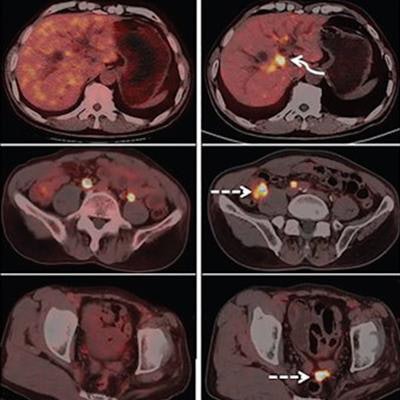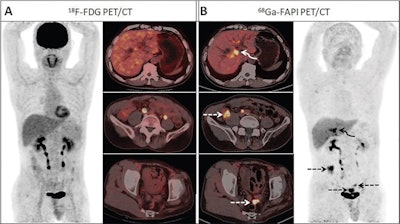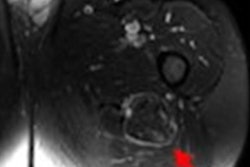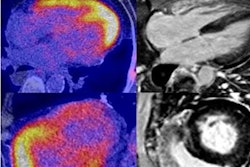
Fibroblast-activation protein inhibitor (FAPI)-PET imaging proved to be superior to current methods such as FDG-PET for staging patients with biliary tract tumors for surgery in a study published May 17 in Radiology.
Chinese researchers compared gallium-68 (Ga-68) FAPI-PET/CT with F-18 FDG-PET/CT for detecting primary tumors and nodal and distant metastases in patients with biliary tract cancer. They found FAPI-PET/CT was superior and showed a significant improvement in the clinical management of patients.
"Results regarding the impact of the tracer on tumor staging were promising and showed great clinical potential for decision making on appropriate treatment options," wrote first author Dr. Lianjun Lan, a radiologist at the Affiliated Hospital of Southwest Medical University in Luzhou.
Biliary tract tumors are a rare but typically fatal type of cancer, given that most patients present with locally advanced or metastatic disease. Surgery is the cornerstone of treatment. Imaging patients to visualize tumors prior to surgery using FDG-PET has limitations, primarily because the tumors tend not to be as hypermetabolic as other malignancies.
 Images from a 59-year-old man who presented with yellow discoloration and pruritus of the skin for three months. A liver function test revealed increased bilirubin. (A) F-18 FDG-PET/CT images demonstrate no abnormal uptake throughout the abdomen, although the corresponding CT scan shows intrahepatic bile duct dilatation. (B) Ga-68 FAPI-PET/CT revealed increased uptake in the perihilar bile duct (SUVmax, 8.2). Three areas of intensive uptake were also observed on the thickening mesentery in the right lower abdomen and pelvic cavity (dashed arrows; SUVmax, 8.6). Slightly elevated Ga-68 FAPI uptake was observed around the dilated intrahepatic bile duct, suggesting cholangitis secondary to obstructive perihilar bile duct carcinoma. Mesentery tissue sample biopsy revealed metastatic adenocarcinoma from biliary cancer. Image courtesy of Radiology.
Images from a 59-year-old man who presented with yellow discoloration and pruritus of the skin for three months. A liver function test revealed increased bilirubin. (A) F-18 FDG-PET/CT images demonstrate no abnormal uptake throughout the abdomen, although the corresponding CT scan shows intrahepatic bile duct dilatation. (B) Ga-68 FAPI-PET/CT revealed increased uptake in the perihilar bile duct (SUVmax, 8.2). Three areas of intensive uptake were also observed on the thickening mesentery in the right lower abdomen and pelvic cavity (dashed arrows; SUVmax, 8.6). Slightly elevated Ga-68 FAPI uptake was observed around the dilated intrahepatic bile duct, suggesting cholangitis secondary to obstructive perihilar bile duct carcinoma. Mesentery tissue sample biopsy revealed metastatic adenocarcinoma from biliary cancer. Image courtesy of Radiology.Ga-68-labeled FAPI is an experimental radiotracer that binds to fibroblast proteins on the surface of cancer cells, thus revealing tumors on PET imaging. In the past few years, FAPI-PET has emerged as a promising approach with high tracer uptake in a variety of cancers.
In this prospective clinical study, Lan and colleagues recruited 16 patients (mean age, 61 years old) at their hospital with newly diagnosed or recurrent biliary tract cancer who were candidates for surgery. They performed FDG-PET/CT scans first (uMI 780, United Imaging), followed by FAPI-PET/CT scans within three days.
Two nuclear medicine physicians, each with more than 10 years of experience, analyzed the images, with histopathologic examination of biopsy or resected surgical specimens serving as a reference for the final diagnosis. The number of lesions and the maximum standardized uptake value (SUVmax) of those with the highest tracer accumulation were recorded for both tracers.
Results revealed the sensitivity of Ga-68 FAPI-PET/CT was higher than that of F-18 FDG-PET/CT for detecting primary tumors, nodal metastases, and distant metastases.
| Sensitivity of Ga-68 FAPI-PET/CT vs. F-18 FDG-PET/CT in biliary tract cancer | ||
| F-18 FDG-PET/CT | Ga-68 FAPI-PET/CT | |
| Primary tumors | 81% | 100% |
| Nodal metastases | 83% | 98% |
| Distant metastases | 79% | 100% |
"Ga-68 FAPI-PET/CT was superior to F-18 FDG-PET/CT for detecting the primary tumor and nodal and distant metastases," the researchers stated.
In addition, Ga-68 FAPI-PET/ CT resulted in new oncologic findings in 10 of 18 patients and upgraded tumor staging or restaging in five of 18 participants compared with F-18 FDG PET/CT, the researchers found.
The study was limited by the small sample size, and to draw any definite conclusions on the diagnostic value of Ga-68 FAPI-PET/CT for biliary tract tumors, the clinical trial results need to be confirmed in a greater number of pathologically proven lesions, the authors concluded.
In an accompanying editorial, Dr. Peter Choyke, chief of the Molecular Imaging Branch of the National Cancer Institute, noted that the relatively short half-life of Ga-68 FAPI (68 minutes) may make it impractical for many medical centers in the U.S. without a nuclear pharmacy in which the agent can be labeled.
"Fortunately, F-18 FAPI agents are already in development and will provide the flexibility and longer half-life (110 minutes) needed for centralized production and distribution in ready-to-inject syringes," he wrote.
The literature surrounding FAPI-PET/CT, only a few years old, is already replete with small studies and case reports testifying to its potential utility, he wrote.
"We all look forward to larger, multi-institutional studies," Choyke concluded.





















